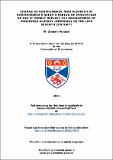Files in this item
Change in Northumbria : was Aldfrith of Northumbria's reign a period of innovation or did it merely reflect the development of processes already underway in the late seventh century?
Item metadata
| dc.contributor.advisor | Woolf, Alex | |
| dc.contributor.author | Watson, W. Graham | |
| dc.coverage.spatial | vi, 308 p. | en_US |
| dc.date.accessioned | 2015-10-06T07:25:39Z | |
| dc.date.available | 2015-10-06T07:25:39Z | |
| dc.date.issued | 2015-11-30 | |
| dc.identifier | uk.bl.ethos.667525 | |
| dc.identifier.uri | https://hdl.handle.net/10023/7607 | |
| dc.description.abstract | This thesis looks at a period of Northumbrian history when the king was a part Irish, Iona trained scholar. Some have suggested that Aldfrith was assisted to the kingship by the northern victors of the battle of Nechtansmere. It examines processes in the late seventh century to try to identify changes that might have happened during the reign of this king. The study begins with a wide overview of previous research to establish a basis from which to look for processes and change and also examines the sources available to us, written and archaeological. It then looks at the kingdoms to the north and west and at Aldfrith and the period of his reign. The suggestion is made that Aldfrith acted, with the Church, to cult saints that were Northumbrian and Romanist, as opposed to other options that might have been available. It proposes that the Northumbrians rejected opportunities to develop links with the north and west that may have been open to them. The following chapters then examine processes underway in Northumbria in three general areas; in the use of power, in society, and in the economy. It concludes that although many processes continued as before, these sped up and in certain areas such as the production of coins, and the consequential development of trade, it was a period of innovation. There is no evidence of a focus to the north and west during Aldfrith’s reign and this has implications for how Aldfrith got to the throne, suggesting that it was with the support of the Northumbrian elite and not through the military strength of the Dál Riata or the Picts. The evidence is that Northumbria increasingly looked south for its influences and is prepared to absorb and implement processes and approaches from southern England, Gaul and Rome. | en_US |
| dc.language.iso | en | en_US |
| dc.publisher | University of St Andrews | |
| dc.rights | Creative Commons Attribution-NonCommercial-NoDerivatives 4.0 International | |
| dc.rights.uri | http://creativecommons.org/licenses/by-nc-nd/4.0/ | |
| dc.subject | Aldfrith | en_US |
| dc.subject | Northumbria | en_US |
| dc.subject | Early medieval | en_US |
| dc.subject | Picts | en_US |
| dc.subject | Dal Riada | en_US |
| dc.subject | West Saxons | en_US |
| dc.subject | Cuthbert | en_US |
| dc.subject | Wilfrid | en_US |
| dc.subject | Theodore | en_US |
| dc.subject | Archaeology | en_US |
| dc.subject.lcc | DA670.N813W2 | |
| dc.subject.lcsh | Aldfrith, King of Northumbria, -705 | en_US |
| dc.subject.lcsh | Northumbria (England : Region)--History | en_US |
| dc.subject.lcsh | Picts | en_US |
| dc.title | Change in Northumbria : was Aldfrith of Northumbria's reign a period of innovation or did it merely reflect the development of processes already underway in the late seventh century? | en_US |
| dc.type | Thesis | en_US |
| dc.type.qualificationlevel | Doctoral | en_US |
| dc.type.qualificationname | PhD Doctor of Philosophy | en_US |
| dc.publisher.institution | The University of St Andrews | en_US |
This item appears in the following Collection(s)
Except where otherwise noted within the work, this item's licence for re-use is described as Creative Commons Attribution-NonCommercial-NoDerivatives 4.0 International
Items in the St Andrews Research Repository are protected by copyright, with all rights reserved, unless otherwise indicated.


